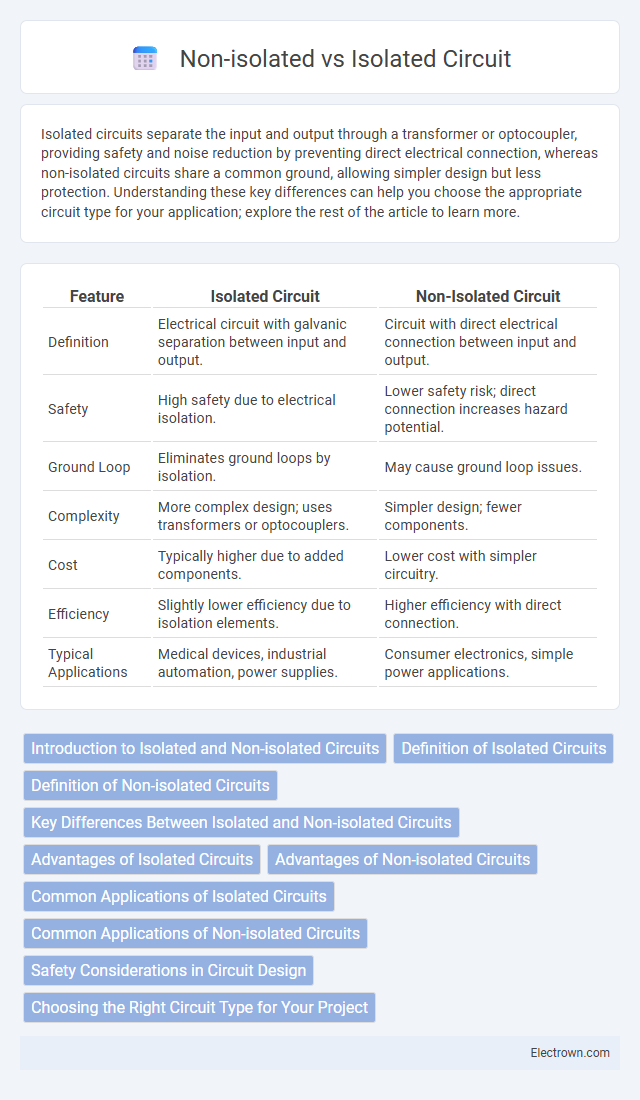Isolated circuits separate the input and output through a transformer or optocoupler, providing safety and noise reduction by preventing direct electrical connection, whereas non-isolated circuits share a common ground, allowing simpler design but less protection. Understanding these key differences can help you choose the appropriate circuit type for your application; explore the rest of the article to learn more.
Table of Comparison
| Feature | Isolated Circuit | Non-Isolated Circuit |
|---|---|---|
| Definition | Electrical circuit with galvanic separation between input and output. | Circuit with direct electrical connection between input and output. |
| Safety | High safety due to electrical isolation. | Lower safety risk; direct connection increases hazard potential. |
| Ground Loop | Eliminates ground loops by isolation. | May cause ground loop issues. |
| Complexity | More complex design; uses transformers or optocouplers. | Simpler design; fewer components. |
| Cost | Typically higher due to added components. | Lower cost with simpler circuitry. |
| Efficiency | Slightly lower efficiency due to isolation elements. | Higher efficiency with direct connection. |
| Typical Applications | Medical devices, industrial automation, power supplies. | Consumer electronics, simple power applications. |
Introduction to Isolated and Non-isolated Circuits
Isolated circuits provide electrical separation between input and output, enhancing safety and preventing ground loops, commonly used in power supplies and medical devices. Non-isolated circuits share a common ground or reference point, offering simpler designs and higher efficiency but less protection against electrical interference. Understanding these fundamental differences is crucial for designing reliable electronic systems with appropriate voltage regulation and noise immunity.
Definition of Isolated Circuits
Isolated circuits are electrical systems designed to prevent direct electrical connection between input and output, often using components such as transformers or optocouplers to transfer signals or power without a conductive path. This isolation enhances safety by reducing the risk of electric shock and protects sensitive components from voltage spikes or ground loops. In contrast, non-isolated circuits have a direct conductive path between input and output, lacking these protective barriers.
Definition of Non-isolated Circuits
Non-isolated circuits refer to electrical configurations where the input and output share a common ground or reference point, allowing direct electrical connection without physical separation. These circuits are simpler, more compact, and cost-effective but may pose safety risks due to the lack of galvanic isolation. Understanding the non-isolated circuit design helps you choose the right solution based on your project's voltage, noise immunity, and safety requirements.
Key Differences Between Isolated and Non-isolated Circuits
Isolated circuits use transformers or optical isolators to separate input and output, providing safety and noise immunity, while non-isolated circuits share a common ground, enabling simpler design and lower cost but less protection against voltage spikes. Key differences include electrical isolation level, complexity, and application suitability, with isolated circuits favored in medical devices and industrial controls. Understanding these distinctions helps you choose the right circuit type based on safety requirements and system design goals.
Advantages of Isolated Circuits
Isolated circuits provide significant advantages by preventing direct electrical connection between input and output, enhancing safety and protecting sensitive components from voltage spikes or ground loops. They improve noise immunity and ensure signal integrity in environments with high electromagnetic interference, making them ideal for medical devices, industrial controls, and communication systems. Your designs benefit from reduced risk of damage and improved reliability when using isolated circuits in critical applications.
Advantages of Non-isolated Circuits
Non-isolated circuits offer advantages such as higher efficiency and simpler designs due to the absence of isolation components like transformers or optocouplers. They typically have lower cost and reduced size, making them suitable for applications where electrical isolation is not critical. Their straightforward structure facilitates faster signal transmission and easier troubleshooting in power supply and electronic systems.
Common Applications of Isolated Circuits
Isolated circuits are commonly used in medical devices, industrial automation, and power supply systems to ensure safety by preventing direct electrical connection between input and output. These circuits provide protection against electric shock and reduce noise interference, making them essential in sensitive environments such as patient monitoring equipment and communication systems. Your electronic designs benefit from enhanced reliability and compliance with regulatory standards when incorporating isolated circuit configurations.
Common Applications of Non-isolated Circuits
Non-isolated circuits are widely used in applications such as DC-DC converters, power supplies for low-voltage electronics, and battery charging systems where direct electrical connection between input and output is required. These circuits offer advantages in terms of efficiency, size, and cost for devices like LED drivers, computer power supplies, and communication equipment. Understanding the common applications of non-isolated circuits can help you select the most suitable solution for efficient and compact power management.
Safety Considerations in Circuit Design
Isolated circuits enhance safety by physically separating the input and output, preventing high voltage from reaching sensitive components or users, thus reducing the risk of electrical shock. Non-isolated circuits lack this separation, which can increase the danger of electric hazards if fault conditions occur. When designing your circuit, prioritizing isolated configurations ensures compliance with safety standards and better protection in high-voltage applications.
Choosing the Right Circuit Type for Your Project
Choosing the right circuit type depends on the specific requirements of your project, such as safety, signal integrity, and power handling. Isolated circuits offer superior protection by preventing direct electrical connection, ideal for high-voltage applications and sensitive electronics. Non-isolated circuits are more cost-effective and compact, making them suitable for low-voltage, less critical systems where electrical isolation is not a priority.
Isolated vs Non-isolated Circuit Infographic

 electrown.com
electrown.com